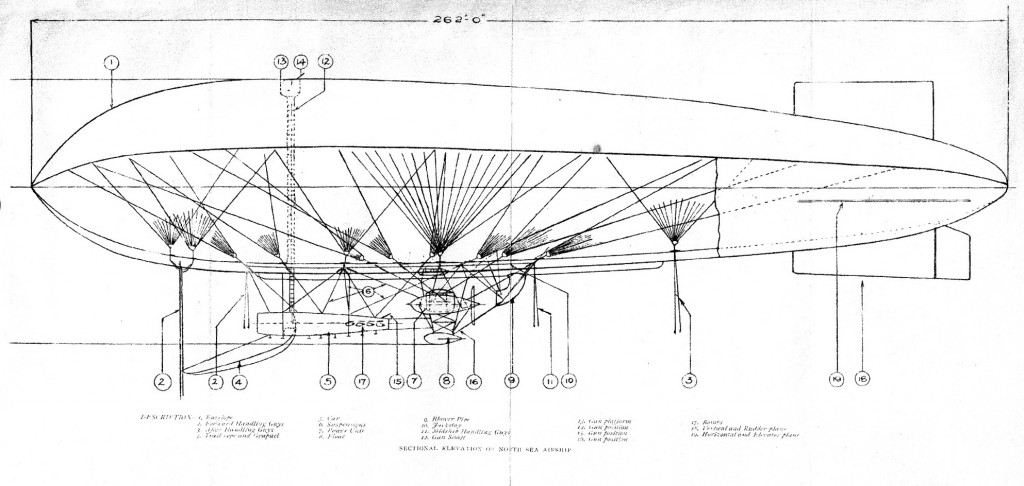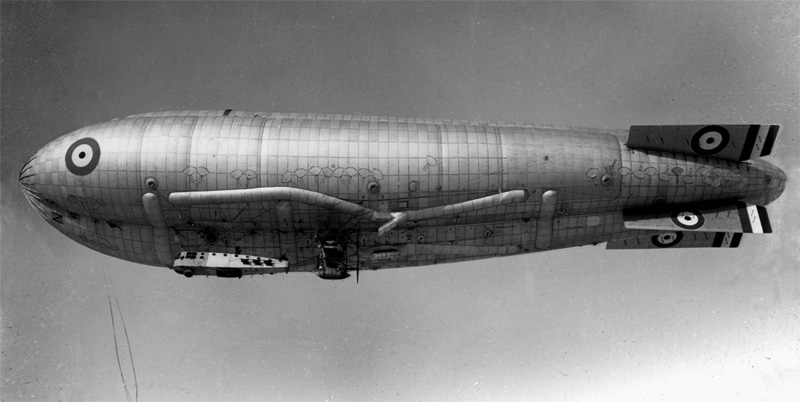With an increasing requirement for the RNAS to provide aerial cover the fleet, the North Sea class airships were introduced in 1917 as a temporary solution until large rigid airships came into service.
The NS class airships were designed with a capability to carry out flights of considerable duration (24 hours) with a speed of 55 to 60 knots while providing comfortable accommodation for the double crew and a high degree of reliability. The North Sea class airship was designed to operate off the east coast of Great Britain and undertake anti-submarine and convoy escort duties.
The first five NS class airships suffered from serious drive-shaft issues which resulted in the forced landing and wrecking of NS2 and NS5. Production was halted until the two 250hp Rolls Royce Eagle engines, with their complex and problematic drive-shaft arrangement, were replaced with direct-drive 240hp Fiat engines. Once the dedicated RNAS personnel (particularly Flight Commander JS Wheelwright and Lieutenant-Commander AS Abell) had ironed out these problems, and following extensive modifications, the NS Class airships proved to be perhaps the finest and most efficient non-rigid airships in the world.
 Based on the Astra-Torres principle the 262ft long streamlined tri-lobe envelope had a capacity of 360,000 cubic feet. The 35ft long control car (as on NS11 but not the Wheelwright-designed ships) was constructed from steel tubes covered in duralumin sheet and fabric. This housed the forward pilot’s cabin, navigation room and wireless telegraphy room as well as officer and crew living and sleeping accommodation (the crew of 10 was split into two watches of five). Cooking was done on a flanged hot-plate fixed to one of the engine exhausts.
Based on the Astra-Torres principle the 262ft long streamlined tri-lobe envelope had a capacity of 360,000 cubic feet. The 35ft long control car (as on NS11 but not the Wheelwright-designed ships) was constructed from steel tubes covered in duralumin sheet and fabric. This housed the forward pilot’s cabin, navigation room and wireless telegraphy room as well as officer and crew living and sleeping accommodation (the crew of 10 was split into two watches of five). Cooking was done on a flanged hot-plate fixed to one of the engine exhausts.
Astern of the control car, and reached by an open walkway, was the engine car with the engines mounted either side. The cars of many of the airships were later modified to either the Kingsnorth-style (as was NS11) or the fully-enclosed Wheelwright-style car. Up to five machine guns could be fitted, with one on the upper platform reached through a climbing shaft. Up to six 230lb bombs were also carried.
Petrol was originally carried in aluminium tanks mounted on the top ridges of the envelope but this system was abandoned owing to the aluminium pipes fracturing dues to expansion and contraction of the envelope. The fuel tanks were subsequently mounted inside the envelope.
The NS Class airships, and in particular NS11, became well-known for breaking flight endurance records for, what were then, unprecedented durations.
Drawing provided by the Airship Heritage Trust


 NS11 – As Bright As Day is very much a work in progress and has been made possible by the generous and enthusiastic support of many individuals and organisations. If you have any information, records or material relating to British NS Class airships we would be very interested to hear from you – especially anyone related to members of the crew of NS11 or any airship of the class during their service with the RNAS or RAF during and beyond WWI.
NS11 – As Bright As Day is very much a work in progress and has been made possible by the generous and enthusiastic support of many individuals and organisations. If you have any information, records or material relating to British NS Class airships we would be very interested to hear from you – especially anyone related to members of the crew of NS11 or any airship of the class during their service with the RNAS or RAF during and beyond WWI.
Latest